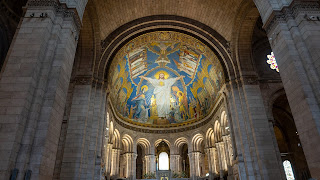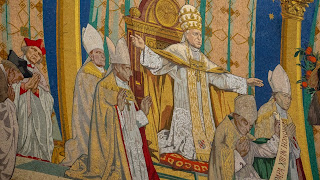We accomplished quite a bit on our first day in Paris. So much so, that we hit the wall and were out before 8PM. Around 2:30AM, I woke up and started looking for food. The mini-bar provided peanuts, Coke Zero and some French chocolate. By 3:30AM, we both were awake and could not fall back to sleep. This was going to be the day we visited some of the great churches in Paris. A check of the list showed St. Gervais, a short walk from our hotel, was opening at 6AM. We got moving and were out the door by 6AM. This was another lesson learned about Paris. There was nothing open at that early hour, just the church. We made our way through the morning mist and arrived at the church.
The church was still dark with just a few candles burning to give off light. We saw a group of religious, men and women, sitting in adoration before the tabernacle. They were have a holy hour. We sat in the front row and finished the holy hour with them.
At 7:00am, they stood up and began to chant the morning office of the church, Lauds. Jennie and I looked at each other and had the same thought...what in the world did we stumble in to. The chants and office of readings were all in French, but it was other worldly. This was not the first time I've every prayed Lauds or Matins. We used to do that in the seminary chapel almost daily. I'm pretty sure it was the first time Jennie had ever experienced Lauds and for sure it was the first time she'd ever heard it chanted as it was meant to be.
Lauds at St. Gervais from Patrick Cullen on Vimeo.
After morning prayer was over we discovered that this was a monastic community known as the Communities of Jerusalem. They were founded in 1975 on All Saints Dayby Pierre-Marie Delfieux with the aim of promoting the spirit of the monastic desert in the heart of the city. The Communities of Jerusalem are present in Paris, Vezelay, Strasbourg, Mont-St. Michel, Florence, Montreal and Rome. Members of the fraternity are called to live the common calling of fraternal life, prayer, work and welcoming others "in the heart of the city", while striving to dwell always in the heart of God. Particular importance is given to the beauty of the liturgy, as oasis for all to draw from morning, noon or evening, respite from the hectic pace of city life in the heart of God.
A visit to this community or one like it should be required for every Bishop, Vocations Director, Seminarian and Liturgist. This is how the Latin church is meant to pray and worship. The "mass" that we are offered at parish churches in the United States is a joke when compared to this.
We left St. Gervais on a high and grabbed some breakfast at the Cafe St. Regis. We wandered over to Notre Dame where they were having daily mass in the chapel just under the high altar. Like good American Catholics we got there just in time for communion 😅, which was distributed by the priest celebrating the mass.
Our plan was to take the Metro to the outer parts of Paris and visit churches, but the rainy weather shut down the Metro stop near Notre Dame. We grabbed an Uber and made our way to 140 rue du Bac, otherwise known as the Chapel of the Miraculous Medal.
On the night of July 18-19, 1830, Sister Catherline Laboure, a novice in the community of the Daughters of Charity in Paris was awakened by a child and summoned to the chapel. The Blessed Mother appeared to Sr. Catherine and spoke with her for several hours. She was told that she was to have a mission. Five months later, on November 27, 1830, Sr. Catherine saw Mary standing on half a globe and holding a golden globe in her hands. On the globe was the word "France" and our Lady explained that the globe represented the whole world, but especially France. Streaming from rings on Mary's fingers were many rays of light. Mary explained that the rays symbolized the graces she obtains for those who ask for them. Some of the gems on her rings were dark and Mary explained that the rays and grace were available but did not come because no one had asked for them.
The third apparition was where the Miraculous Medal was shown to Sr. Catherine. Mary was standing upon a globe, crushing the head of a serpent beneath her foot. (Gn 3:15). Framing this were the words Ô Marie, conçue sans péché, priez pour nous qui avons recours à vous (O Mary conceived without sin, pray for us who have recourse to thee). This was 24 years prior to the declaration of the Immaculate Conception by Pope Pius. On the reverse side of the medal where 12 stars which can represent the Apostles who represent the entire church as it surrounds Mary. (Rev 12:1). The cross symbolizes Christ and our redemption, the M stands for Mary.
Sr. Catherine was told to have a medal struck upon this model. Those who wear it will receive great graces, especially if they were it around the neck. The first medals were struck in Paris in 1832. Almost immediately the blessings that were foretold began to shower down on those who wore the Miraculous Medal. The devotion spread quickly and a canonical inquiry started in Paris declared the apparitions to be genuine.
Sr. Catherine died on December 31, 1876. She was beatified in 1933 and when her body was exhumed after 57 years of burial, it was found to be completely incorrupt and supple. Her incorrupt body lays on the side altar in the Church of the Miraculous Medal.
We left the church and walked a couple of blocks to the Shrine of St. Vincent de Paul. Immediately upon entering the shrine we noticed a glass reliquary containing the body of St. Vincent de Paul. When his body was first exhumed it appeared to be incorrupt. However, flooding damaged the area where his body was placed and the body did decay. Housed in the reliquary was his skeleton covered in wax. His heart was taken and housed in the Shrine of the Miraculous medal on the left side altar. St. Catherine Laboure lies under the right side altar.
There are steps behind the altar that lead up to reliquary. We made the walk and venerated this great saint.
We grabbed lunch in a nearby bistro and found a working metro stop. We took the metro to the northern part of Paris to a location known as Montmartre. This is a large hill, 430 feet above Paris and the location of Sacre Coeur Basillica. We made the trek up the hill, only stopping a few times for rest! We were greeted with an incredible view of Paris and an even more impressive view of the basillica.
In 1870 war broke out between France and Germany. The church council being held was suspended and the Pope, no longer under protection of the French troops, considered himself a prisoner in the Vatican. France was defeated by Germany and partially occupied. Alexandre Legentil and Hubert Ronhault de Fleury vowed to build a church dedicated to the Sacred Heart, as reparation for infidelity and sin of France. The vow was approved by Cardinal Guibert and the site on Montmartre was chosen. The basilica was constructed in the Byzantine style.
We grabbed a snack and coffee at a local bistro in Montmartre and found our way to the Metro. We took it to Ile de La Cite and found another one Jennie's top picks, St. Chapelle. My wife is a bona-fide fan of Bishop Robert Barron. In his series Catholicism, there is a view of a beautiful church with stained glass and lights. She always assumed that was Notre Dame, but it was St. Chapelle. I had read this but didn't tell her that until we walked in. The irony of it was she almost didn't go in as the call of nature and a longish line was weighing on her. Fortunately our Paris Pass gave us the ability to bypass the line and soon we saw the interior of this beautiful chapel.
St. Chapelle is a royal chapel built in the Gothic style within the grounds of the Palais de la Cite. It was built in 7 years, being consecrated in 1248. It was commissioned by King Louis IX to house his collection of Passion relics, including the crown of thorns. The most famous feature of the chapel are the great stained glass windows. The three windows of the eastern apse illustrate the New Testament. By contrast, the windows of the nave are dominated by Old Testament exemplars of ideal kingship/queenship in a nod to their royal patrons. The cycle starts the Genesis, Exodus, Joseph, Numbers/Leviticus, Joshua/Deuteronomy, Judges, Jeremiah/Tobias, Judith/Job, Esther, David and Kings. The final windows brings this narrative of sacral kingship up to date with scenes of the rediscovery of Christ's relics, the miracles they performed, and their relocation to Paris.
The chapel was damaged during the French Revolution where relics were dispersed and many reliquaries were melted down. Today St. Chapelle is a national monument and has been since 1862.
We went back to the hotel to clean up and find dinner for the night. We ended up at a restaurant down the street from the hotel called Sorza. There we had some great Bordeaux wine, along with the finest Pasta Bolognese and Parmesan Risotto. After dinner we walked along the banks of the Seine and watched the sun setting over Notre Dame. And there was evening, and there was morning - the second day.
Subscribe to:
Post Comments (Atom)
France - Day 10 (June 10)
Today was our last full day in Paris. We were up relatively early as Jennie had booked a 1/2 day trip to Monet's Garden in Givern...

-
Today was our last full day in Paris. We were up relatively early as Jennie had booked a 1/2 day trip to Monet's Garden in Givern...
-
***The names have been blurred to protect the idiots , I mean contributors.*** When I said "I Do" in June, apparent...
-
Discernment is a word in the English language that does not get used much in our modern world. In a Christian context, it is perception in ...





































No comments:
Post a Comment